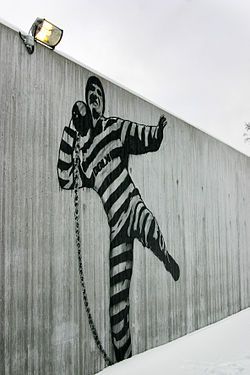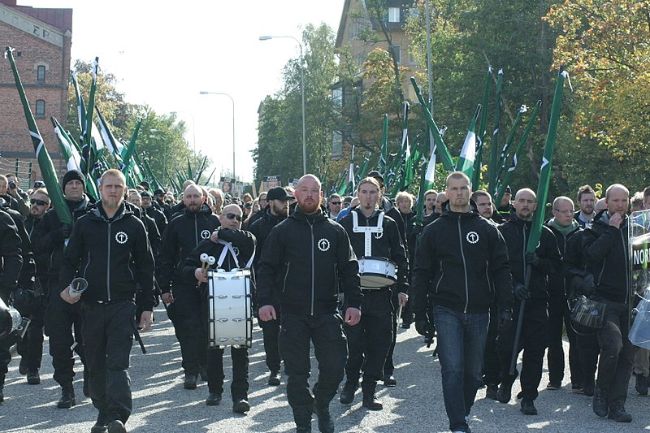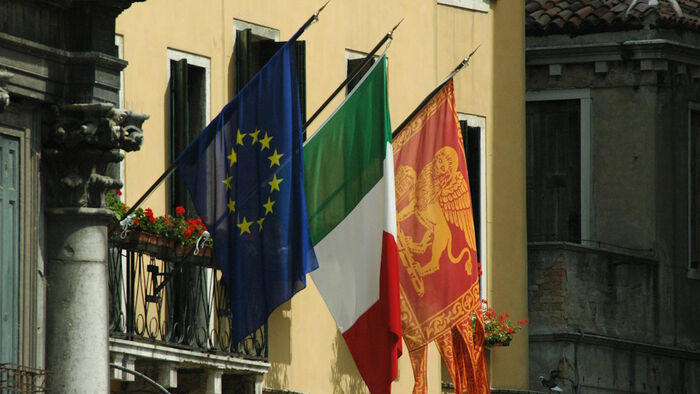First, what do we mean by such concepts as right-wing extremism? In research on the so-called far right, it is widely accepted among scholars to make a distinction between the radical right and the extreme right. They share some form of nativism or ethnic nationalism as well as intolerance towards diversity. However, radical right actors operate within democratic boundaries, whereas extreme right actors openly reject democracy and universal human rights, and consider violence against “enemies of the people” to be legitimate.
Racist youth cultures are gone
One of the most striking developments in Norway and many other countries is that right-wing extremism is no longer a typical youth problem anymore, but rather such organisations and movements are now almost exclusively constituted by adults. During the 1990s and early 2000s there were some rather big extreme right youth subcultures and groups in Norway and other Western countries. These movements were mainly associated with the skinhead sub-culture (in Norway represented by groups like Boot Boys), as well as white power music bands and concerts, and neo-Nazi organisations that appealed to some marginalized and vulnerable youths (e.g. Vigrid). Most participants were recruited into these scenes as teenagers, the groups themselves fulfilling some basic social needs such as friendship, identity, protection, excitement and group belonging. In the skinhead movement in particular, violence and hatred against opponents, immigrants, and other marginalized groups had a value on its own. Their visual style was easily recognizable in the street, which frequently led to violent clashes with opponents, such as left-wing and anti-fascist militants.
There are hardly any such extreme right or racist youth scenes left in Norway today. There are no attractive social arenas that can pull youths into extreme-right or racist movements, and neither is there a White Power music scene, as there was during the 1990s. The main neo-Nazi organisation, the Nordic Resistance Movement, has some 30-40 activists in Norway, maybe 4-500 in Sweden, and around 100 in Finland and Denmark. However, the members of this organisation are adults, typically between the age of 20 and 50, and at least in Norway, there are hardly any teenagers. Apparently, the group’s very strict rules and way of life does not seem to appeal to many young people. The National Socialist ideology appears outdated.
Vigilante groups like the Soldiers of Odin was mainly a community of some young men and a few women between 20 and 40, rather than a group appealing to teenagers. Generation Identity, an ethno-nationalist movement that has succeeded in recruiting students and other resourceful youths in some European countries, has not yet been able to gain any significant foothold in Norway. However, this is probably the kind of far right movement that might have a potential to recruit among Norwegian youths.
Radical right organisations against immigration and islamisation, like Stop Islamisation of Norway/Denmark/Europe, Pegida and the English/Norwegian Defence League, the People’s Movement against Immigration (FMI) and a party called “The Democrats”, typically consist of adults and elderly, but there is hardly any youths to be seen in these organisations.
One main reason for this shift away from right-wing extremism among youths is that fear of foreigners – xenophobia – has gradually been reduced among the younger generations in Norway. Several attitudinal surveys have shown that xenophobia is mainly retained among the older generations. Young people today are growing up in a multicultural society, and they are accustomed to schoolmates and friends from different cultural, religious and racial backgrounds. This is not the same with elderly people, who are much more worried by “foreign” faces and cultures.
This change has major consequences for how to prevent right-wing extremism, and which agencies possess the relevant resources and measures to do so. When the target group for prevention back in the 1990s and early 2000s were mainly teenagers, there was a large prevention apparatus in the municipalities focusing on children and youths: The school system, for instance, has teachers tasked with following up pupils with various problems and pupils who dropped out of school. There were school nurses, youth workers, psycho-social teams for youths, child protection services, youth clubs, sports clubs and other free-time activities.

Photo: Halden Prison
There was also a close collaboration between preventive police, schools and social services to follow up youth at risk or involved with drugs, gangs, violence or extremism. All these services and preventive measures – core elements in the Scandinavian welfare state – are irrelevant when the target group is no longer teenagers but young adults or elderly people from 18 to 80. New approaches are necessary and other actors and agencies must get involved. The Correctional Service (prison service), the employment service and various health services are important actors in dealing with these adult militants, although the police and the security service will play a major role in preventing these adult activists from committing crimes, and follow them up with more repressive measures if they do.
From street activism to internet activism – and back to the street?
Another significant change during the last decades is that the arenas for extremist activism to a large extent – but not completely – have moved from physical meetings and street activism onto the Internet in the forms of web pages, blogs and various types of social media (such as Facebook, Twitter, YouTube, Telegram, etc).
This change has several consequences: the threshold for participating in discussions and exchange of opinions has become lower. It is also much easier to find people sharing your particular views on the Internet than in traditional social arenas. In discussion fora at Facebook or other social media you can get your radical views confirmed and reinforced through interaction with likeminded peers, leading to a radicalisation of your own worldview. The threshold is lower for expressing extremist attitudes or making hateful or threatening statements. The increase in hate speech and threats against politicians that has been measured is several studies during the last few years is mainly reflecting an increase in such statements in social media. Such hate speech and threats may become so stressful and frightening that some top politicians have considered giving up their political positions and public engagement activities.
Another reason for the increase in extreme-right activism on the Internet is that the risk to participate in such activities is much lower in on-line activism than in off-line activities. There is little risk for being physically attacked by militant anti-racists. Indeed, more broadly, when extremist activism is mainly taking place in the virtual space there are fewer opportunities for physical and violent clashes with political opponents. The experience from Norway during the 1990s and early 2000s was that such confrontations could have radicalising impact on both sides and cause a spiral of violence. In Norway, this form of violent conflict dynamics has been relatively absent during the last 15 years. Hate crime in the form of violence, harassment and threats does still happen in the physical space but most of this aggression and hatred is now coming out as hate speech and harassment in social media. Because the threshold for making such hateful statements has been lowered, the volume of it has also increased. When my colleague Jacob Aasland Ravndal in his PhD thesis finds that the number of right-wing extremist attacks in Western Europe has been reduced in the period between 1990 and 2015, one of the possible explanations he provides is that a large part of extremist political activism has moved from the physical space to on-line activism.
However, street activism has not ended completely, and some far-right and extreme-right groups have even re-invigorated their street-level activity. Some anti-Islam groups have had a number of street stands to propagate their message, although with limited participation. In many cases, their talks have been drowned out by shouting from counter-demonstrators. There have also been two main attempts to mobilise mass demonstrations against immigration and Islam, but both failed.  The English Defence League, which has mobilised thousands in the UK, inspired the Norwegian Defence League, but the turn-out was very low. The same happened with the Norwegian off-shoot of the German Pegida movement, which mobilised tens of thousands in cities like Dresden in Germany. Their Norwegian subsidiary got some attention initially, but it soon petered out.
The English Defence League, which has mobilised thousands in the UK, inspired the Norwegian Defence League, but the turn-out was very low. The same happened with the Norwegian off-shoot of the German Pegida movement, which mobilised tens of thousands in cities like Dresden in Germany. Their Norwegian subsidiary got some attention initially, but it soon petered out.
However, the Nordic Resistance Movement has succeeded in organising some rather large street demonstrations, in particular in Sweden, with up to 500 participants marching with flags, uniforms and shields. In Norway they have only managed to mobilise 70 and 50 participants in two demonstrations, and the majority of the demonstrators were Swedish activists, not Norwegians. However, what makes the demonstrations of the Norwegian Resistance Movement more powerful and scary than their limited numbers should entail is that they act in a very disciplined way, almost in military order, with banners and uniforms. Previous Norwegian neo-Nazis have never been able to act like that, even if the Norwegian branch of the Nordic Resistance movement could not have done this without a lot of support from their Swedish partners.
The Nordic Resistance Movement claims that violence will be necessary to achieve their revolution but they do not consider it strategically useful to make use of it at this stage. Their rhetoric is very violent, though, carrying posters with pictures of politicians and others they claim are “traitors of the people” during their demonstrations, and also putting up posters saying that traitors shall be hanged. However, they rarely initiate violent attacks against opponents, although they are ready to attack anyone who provoke them. In Finland, an activist kicked down a person who said something against the group. He died a few days later. The organisation has now been banned by the court in Finland. In Norway, however, the police cannot ban the Nordic Resistance Movement from staging marches and demonstrations as long as they operate within the boundaries of the law and the freedom of expression. In one case, the police banned their demonstration due to the risk of violent clashes with militant counter-demonstrators. This decision was strongly criticised by legal experts on human rights. Handling demonstrations by national socialists – declared enemies of democracy and human rights – is a dilemma the police will continue to face for the foreseeable future.
One of the consequences of activism transferring from the street to the web and social media is that most of the activism is no longer linked to a geographical location where there is an apparatus for prevention. That means that there is not necessarily any particular agency who feels responsible to intervene against hate speech or individuals who cross the line. Previously, the local police knew the individuals who had extremist inclinations. In the present situation, such individuals and incidents might be detected by or reported to central units in the police or security service – or not. These units may – or may not – send the cases to the local police and ask them to intervene. In Norway, the National Criminal Investigation Service has for some years had a so-called Net Patrol, but until now, they have not had the capacity to actively monitor the web and social media. It has mainly functioned as an Internet portal – a virtual police station – where people can report incidents. Beginning in January 2019, the National Criminal Investigation Service has set up a new centre for digital policing, tasked with doing more active patrolling on the net. The police do prosecute a number of cases of hate speech and threats made through social media, and there have been several convictions during the last few years. Many cases are in the grey area of legality, though. However, the police has developed another measure that has proven to be quite effective: giving warnings and using preventive dialogue to make people change their behaviour, as well as using dialogue to assess whether there is a risk that the offender might actually do something more than making verbal threats.
Globalisation and transnational diffusion
Globalisation is not a new phenomenon when it comes to political extremism in general and right-wing extremism in particular. Militant ideologies and modes of action have spread from country to country and inspired new groups and generations, as evidenced by Italian fascism, German National Socialism, American racism and fascist skinhead culture from England. However, previously, this travelling of extremist ideas, social movements and action forms happened rather slowly. It took almost a decade before the racist skinhead style took foothold among groups of youths in Norway, and more than a decade before it faded away.
During the last 10-15 years the diffusion of radical and extremist movements has accelerated amazingly. Concepts, names and action forms like PEGIDA, the English/Norwegian Defence League and the Soldiers of Odin took merely days or weeks from they emerged in Germany or Finland until an off-shoot was planted in Norway. Within a few months in 2016, Soldiers of Odin spread to more than 20 countries. However, these off-shoots had a rapid growth before they dried out and disappeared. Apparently, they did not find a fertile ground and failed to set down roots.
The news media played a major role in the launching of these new, imported groups. When the Norwegian Defence League, Pegida and the Soldiers of Odin staged their first events, there were often more journalists than activists or demonstrators present, giving the upstarts a lot of publicity to start with.
The contrast to these rapid-growing but failed off-shoots was the Norwegian Resistance Movement, which was an off-shoot of the original Swedish Resistance Movement. Both the Swedish, Finnish and Norwegian branches have spent years to build a disciplined, hierarchical organisation with a solid stem of activists, who, though small in number, are very dedicated.
Islam as the new main enemy
The organised opposition to immigration that emerged during the late 1980s with the establishment of the People’s Movement against Immigration and similar organisations were, to begin with, a rather marginal and stigmatized movement. The movement was characterized by an extremist, rude rhetoric which justified violence against their opponents, described as “national traitors”. During the last 15 years the general opposition against immigration has moved towards a more specific fight against Islam and immigration by Muslims. This skepticism against Islam is no longer mainly associated with marginal groupings but has now made inroads into the political mainstream. In the aftermath of the 9-11 attacks in the USA in 2001 and a series of lethal terrorist attacks in Europe during the following years, militant Islamism and jihadi terrorism now appears as a real threat to ordinary people in Norway as well as to the rest of Europe. Moreover, many feel that conservative Islamist customs and dress codes have spread in ways that is challenging liberal Norwegian and European values and norms.
Another significant development is that some of the leading anti-Islam activists have a political background which is not from the far right but rather from the radical or liberal left, from anti-religious secularism and from the feminist movement. In contrast to the traditional anti-immigration movement, which often appeared as reactionary male chauvinists, many opponents of Islam today present themselves as defenders of women’s liberation, gender equality and gay rights. For some of the anti-Islam activists, these are genuine liberal values, whereas others who voice these arguments appear more as opportunists in this regard. However, within the anti-Islam movements, old-fashioned extreme-right attitudes live side-by-side with liberal and secular values.
The boundaries for what is acceptable to express publicly about Muslims and Islam has moved considerably during the previous 10-15 years. Much of what is said in the public, would not have been acceptable if one said “Jew” rather than “Muslim”. Leading Norwegian politicians have made statements about a “sneaky islamisation of Norway” and similar statements that contributes to a normalization of claims that their political opponents have deliberately facilitated an Islamic “invasion” of Europe. A likely consequence of pointing out Islam as the new main enemy is that an increasing share of extreme-right violence and hate crime is now directed specifically against Muslims. In particular, women wearing hijab or niqab have become victims of hateful harassment and violence. It is laudable that the Norwegian government has recently launched an action plan against anti-Semitism.  However, there is an even greater need for a preventive strategy against Islamophobia.
However, there is an even greater need for a preventive strategy against Islamophobia.
[This text is part of a research report from the Norwegian Police University College Høyreekstremisme i Norge: Utviklingstrekk, konspirasjonsteorier og forebyggingsstrategier (Right-wing extremism in Norway: Developments, conspiracy theories and strategies for prevention), with contributions from Tore Bjørgo (editor), Cora Alexa Døving, Terje Emberland, Ingvild Magnæs Gjelsvik, and Birgitte P. Haanshus. The full text of the report (in Norwegian) can be downloaded here]
.jpg)




